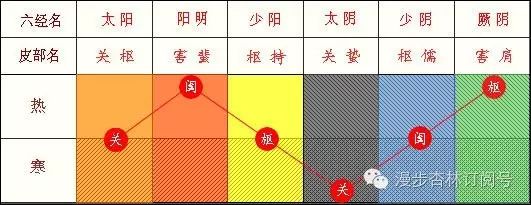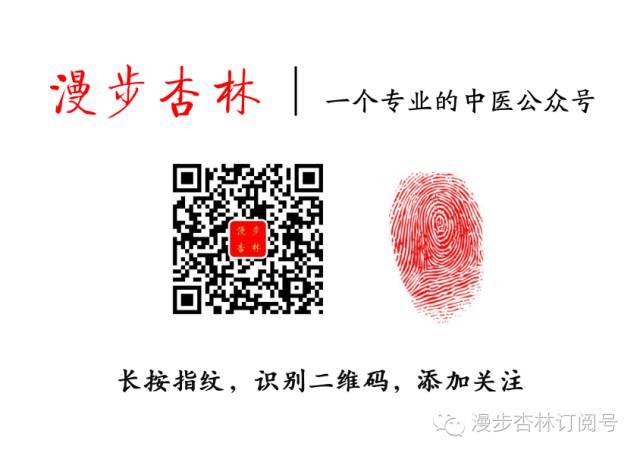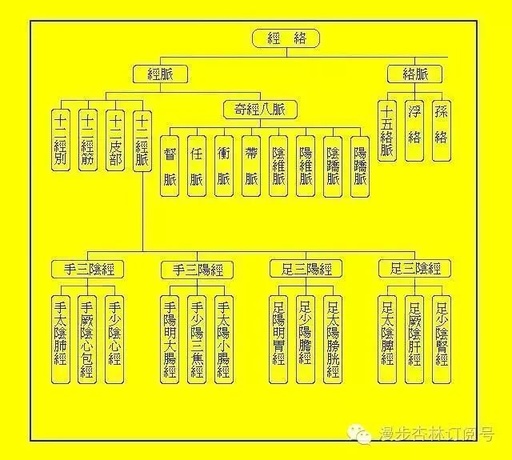The Six Jing Skin Areas
The skin of the entire body is divided into twelve areas according to the distribution of the twelve meridians. In the “Su Wen: Discussion on the Skin Areas,” it states: “To understand the skin areas… one must refer to the meridians, and this applies to all meridians.” When the hand and foot meridians share the same name, they are referred to as the Six Jing Skin Areas. Each of the Six Jing Skin Areas has a specific name: the Taiyang skin area is called Guan Shu, the Yangming skin area is called Hai Fei, the Shaoyang skin area is called Shu Chi, the Taiyin skin area is called Guan Zhe, the Shaoyin skin area is called Shu Ru, and the Jueyin skin area is called Hai Jian. Detailed descriptions are provided for each area.
The Concept of Skin Areas
The skin areas are regions of the skin categorized according to the associated meridians. The distribution of the twelve meridians and their collaterals is divided into twelve skin areas. This reflects the functional activities of the meridians on the body surface and represents the outermost layer of the skin, collaterals, meridians, and internal organs.
The “Su Wen: Discussion on the Skin Areas” states: “To understand the skin areas, one must refer to the meridians, and this applies to all twelve meridians.” It also states: “All twelve meridians are skin areas.”
The meridians are distributed in linear patterns, while the collaterals are distributed in a net-like pattern, and the skin areas are defined as surfaces. The twelve skin areas, where the hands and feet connect, are referred to as the Six Jing Skin Areas.
Diseases within the body can be reflected on the skin through the meridians; external pathogens or treatment methods can influence the meridians and internal organs from the skin, thus external diagnostic methods (external examination) and external treatment methods (external therapy) are most closely related to the skin areas.
The Six Jing Skin Areas and Diagnosis and Treatment
The diagnosis and treatment of skin areas primarily focus on Wei Qi (Defensive Qi) and collaterals.
Skin area diagnostic methods, also known as collateral diagnosis, mainly involve examining the color changes of the skin and collaterals, which is part of the color diagnosis in Traditional Chinese Medicine. The “Su Wen: Discussion on the Skin Areas” states: “If the color is predominantly blue, there is pain; if predominantly black, there is obstruction; if yellow or red, there is heat; if predominantly white, there is cold.” In modern times, based on skin color diagnosis, there are also observations of skin rashes (mainly on the back), examination of subcutaneous hardening reactions, differences in skin sensation, and changes in electrical conductivity, which serve as diagnostic methods, representing the development of external diagnostic methods for skin areas.
Treatment methods for skin areas include various superficial needling techniques and multiple non-needling external therapies. The “Ling Shu: Official Needling” primarily focuses on needling the skin, with techniques such as half-needling and fine needling. The modern application of skin needling has developed from this. The tapping of skin needles and the along-skin needling of wrist and ankle needles are applied in conjunction with the division of skin areas. Other methods such as intradermal needling, prick needling, application methods, warming moxibustion, and bloodletting cupping are all based on the same principle. The division of skin areas expands the application of needling and moxibustion methods.
The Six Jing Skin Areas and Pattern Differentiation
The “Su Wen: Discussion on the Skin Areas” states: “The skin has divisions, the meridians have records, the tendons have connections, and the bones have measurements; the diseases arising from these are different. Distinguishing their divisions—left and right, up and down, yin and yang—indicates the beginning and end of the disease.” This means analyzing the characteristics and developmental changes of diseases from different parts of the skin, meridians, tendons, and bones. The divisions of the skin must distinguish between left and right, up and down, and yin and yang, as well as analyze the development process of the disease (beginning and end). Thus, the symptoms associated with the Six Jing Skin Areas are not solely classified by location but also consider the nature and progression of the disease. Therefore, the “Nei Jing” generally arranges the differentiation of the Six Jing in a specified order: Taiyang, Yangming, Shaoyang, Taiyin, Shaoyin, and Jueyin. Zhang Zhongjing’s “Shang Han Lun” inherits this theory and applies it specifically to pattern differentiation. Later scholars have noted that the Six Jing in the “Shang Han Lun” does not refer to a linear meridian but rather to “divisional locations.”
The naming of the Six Jing Skin Areas contains profound meanings related to the changes in Qi dynamics, which can be understood in conjunction with the characteristics of the Six Jing disease patterns, analyzed through the comparative relationships of yin and yang, exterior and interior, cold and heat, and deficiency and excess. Refer to the “Shang Han Lun Tiao Bian” for further details.
Ke Yunbo in “Shang Han Lun Yi” further clarifies: “The ‘Discussion on the Skin Areas’ states that the skin has divisions… this is the original establishment of the Six Jing locations by Zhongjing,” and states: “Zhongjing’s Six Jing refers to six regions, covering a broad area. Although it refers to the meridians, it does not solely focus on the meridians. All wind, cold, damp, heat, internal injuries, and external pathogens, from the exterior to the interior, whether cold or hot, deficient or excess, are all encompassed.” This indicates that the Six Jing Skin Areas summarize the patterns of exterior and interior, cold and heat, deficiency and excess, serving as a guideline for pattern differentiation and treatment.
The Six Jing Skin Areas and the Concepts of Guan, He, and Shu
Concepts of Guan, He, and Shu
1. The original meanings of Guan, He, and Shu refer to the functional characteristics of the three Yang and three Yin, combined with the naming of the Six Jing roots and skin areas, providing guidance for pattern differentiation and treatment of the Six Jing. Guan, He, and Shu originally refer to physical components of a door. Guan: “According to the Shuowen,” refers to a wooden bar holding the door, indicating a door bolt; He: “According to the Shuowen,” refers to the door leaf; Shu: “According to the Shuowen,” refers to the door hinge.
2. The functions and positions of Guan, He, and Shu: Guan: primarily closes and opens, located at the back; He: the main body of the door, primarily for defense, located at the front; Shu: primarily rotates, located at the side. The meanings and main content of Guan, He, and Shu are used by ancient physicians to metaphorically explain the changes in Qi dynamics of the three Yang and three Yin, elucidating the normal functions of the Six Jing Skin Areas. The three Yang are like the outer door, and the three Yin are like the inner door, each having distinctions of Guan, He, and Shu. The initiation of yin and yang is referred to as “Guan”; the flourishing of Yang or the decline of Yin is referred to as “He”; the transformation of yin and yang is referred to as “Shu.”
The three Yang: Taiyang is Guan, Yangming is He, and Shaoyang is Shu. The three Yin: Taiyin is Guan, Shaoyin is Shu, and Jueyin is He. The door Guan primarily serves to restrict. The Bladder meridian of the Taiyang primarily restricts the flow of fluids to the pores, thus it is Guan. The Spleen meridian of the Taiyin primarily restricts the Qi of food and water, ensuring it is absorbed without loss, thus it is also Guan. The door He refers to the door leaf, primarily serving to close. The Stomach meridian of the Yangming ensures that the true Qi stops and does not stagnate, thus it is He. The Liver meridian of the Jueyin primarily guards the spirit and regulates the flow of emotions, thus it is also He. The door Shu primarily serves to rotate. The Gallbladder meridian of the Shaoyang primarily governs the tendons and connects the bones, allowing for movement, thus it is Shu. The Kidney meridian of the Shaoyin primarily governs the flow of fluids and connects the various meridians, thus it is also Shu.
The Six Jing Skin Areas are regions of the skin categorized according to the associated meridians. The distribution of the twelve meridians and their collaterals is divided into twelve skin areas. This reflects the functional activities of the meridians on the body surface and represents the outermost layer of the skin, collaterals, meridians, and internal organs. The meridians are distributed in linear patterns, while the collaterals are distributed in a net-like pattern, and the skin areas are defined as surfaces. The twelve skin areas, where the hands and feet connect, are referred to as the Six Jing Skin Areas. Diseases within the body can be reflected on the skin through the meridians; external pathogens or treatment methods can influence the meridians and internal organs from the skin, thus external diagnostic methods (external examination) and external treatment methods (external therapy) are most closely related to the skin areas.
The Six Jing Skin Areas and the Concepts of Guan, He, and Shu. Taiyang is the “Guan” of the three Yang, governing the exterior of the body, regulating Wei and responding to the skin and hair, serving as a barrier for the various meridians, and the associated skin area is called “Guan Shu.” The Yangming skin area is “Hai Fei.” Yangming represents the exuberance of Yang Qi, being the “He” of the three Yang. With abundant Qi and blood, it serves as the sea for the five internal organs. The associated skin area is called “Hai Fei,” where “Fei” means the soaring of Yang Qi. The Shaoyang skin area is “Shu Chi,” representing the “Shu” of the three Yang, adjacent to Taiyang and connecting to Yangming, responsible for ascending and descending, allowing for entry and exit like a pivot, and the associated skin area is called “Shu Chi.” The Taiyin skin area is “Guan Zhe.” Taiyin is the “Guan” of the three Yin, also serving as the portal for pathogens to enter and exit, with cold pathogens directly invading, first harming Taiyin, where diseases enter through the mouth, directly affecting Taiyin. The Taiyin Spleen is associated with warmth and dislikes dampness. When pathogens invade Taiyin, they often transform from cold and damp. The associated skin area is called “Guan Zhe,” where “Zhe” means the dominance of Yin and the retreat of Yang. The Shaoyin skin area is “Shu Ru,” representing the “Shu” of the three Yin, and the associated skin area is called “Shu Ru” (Yin Shu), in contrast to Shaoyang. The Jueyin skin area is “Hai Jian,” representing the “He” of the three Yin, where the two Yin intersect, indicating that the development of Taiyin and Shaoyin diseases culminates in Jueyin disease, which is the final stage of the transformation of the Six Jing disease patterns. The associated skin area is called “Hai Jian,” where “Jian” means to bear the burden.


↓↓↓ Scan to follow “Walking in the Apricot Forest” for more Traditional Chinese Medicine knowledge


